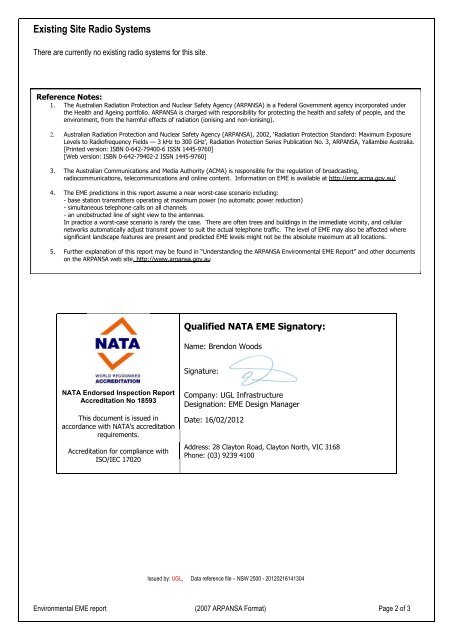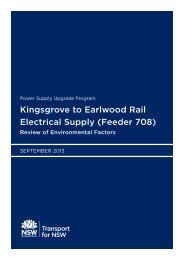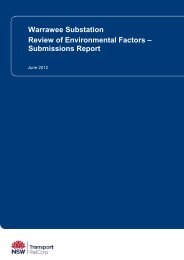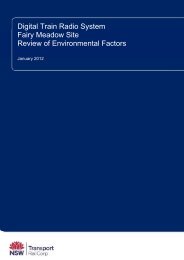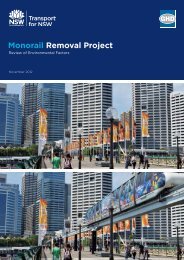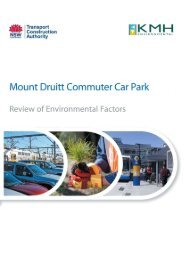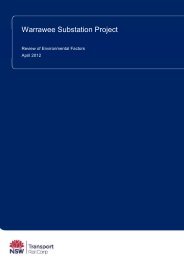Review of Environmental Factors - Transport for NSW - NSW ...
Review of Environmental Factors - Transport for NSW - NSW ...
Review of Environmental Factors - Transport for NSW - NSW ...
Create successful ePaper yourself
Turn your PDF publications into a flip-book with our unique Google optimized e-Paper software.
Existing Site Radio SystemsThere are currently no existing radio systems <strong>for</strong> this site.Reference Notes:1. The Australian Radiation Protection and Nuclear Safety Agency (ARPANSA) is a Federal Government agency incorporated underthe Health and Ageing portfolio. ARPANSA is charged with responsibility <strong>for</strong> protecting the health and safety <strong>of</strong> people, and theenvironment, from the harmful effects <strong>of</strong> radiation (ionising and non-ionising).2. Australian Radiation Protection and Nuclear Safety Agency (ARPANSA), 2002, ‘Radiation Protection Standard: Maximum ExposureLevels to Radi<strong>of</strong>requency Fields — 3 kHz to 300 GHz’, Radiation Protection Series Publication No. 3, ARPANSA, Yallambie Australia.[Printed version: ISBN 0-642-79400-6 ISSN 1445-9760][Web version: ISBN 0-642-79402-2 ISSN 1445-9760]3. The Australian Communications and Media Authority (ACMA) is responsible <strong>for</strong> the regulation <strong>of</strong> broadcasting,radiocommunications, telecommunications and online content. In<strong>for</strong>mation on EME is available at http://emr.acma.gov.au/4. The EME predictions in this report assume a near worst-case scenario including:- base station transmitters operating at maximum power (no automatic power reduction)- simultaneous telephone calls on all channels- an unobstructed line <strong>of</strong> sight view to the antennas.In practice a worst-case scenario is rarely the case. There are <strong>of</strong>ten trees and buildings in the immediate vicinity, and cellularnetworks automatically adjust transmit power to suit the actual telephone traffic. The level <strong>of</strong> EME may also be affected wheresignificant landscape features are present and predicted EME levels might not be the absolute maximum at all locations.5. Further explanation <strong>of</strong> this report may be found in “Understanding the ARPANSA <strong>Environmental</strong> EME Report” and other documentson the ARPANSA web site, http://www.arpansa.gov.auQualified NATA EME Signatory:Name: Brendon WoodsSignature:NATA Endorsed Inspection ReportAccreditation No 18593This document is issued inaccordance with NATA’s accreditationrequirements.Accreditation <strong>for</strong> compliance withISO/IEC 17020Company: UGL InfrastructureDesignation: EME Design ManagerDate: 16/02/2012Address: 28 Clayton Road, Clayton North, VIC 3168Phone: (03) 9239 4100Issued by: UGL, Data reference file – <strong>NSW</strong> 2500 - 20120216141304<strong>Environmental</strong> EME report (2007 ARPANSA Format) Page 2 <strong>of</strong> 3


